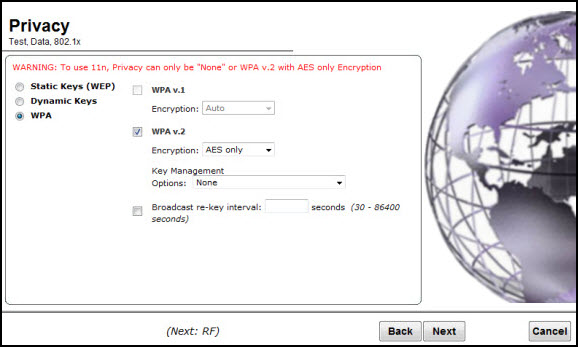The Privacy screen displays:

Data VNS Privacy Page - Fields and Buttons
| Field/Button | Description |
|---|---|
| Static Keys (WEP) | Select to configure static keys. Then
enter:
Select an Input Method:
|
| Dynamic Keys | Select to allow the dynamic key WEP mechanism to change the key for each user and each session. |
| WPA | Select to configure Wi-Fi Protected Access
(WPA v1 and WPA v2), a security solution that adds authentication to
enhanced WEP encryption and key management. To enable WPA v1 encryption, select WPA v.1. In the Encryption drop-down list, select one of the following encryption types:
To enable WPA v2 encryption, select WPA v.2. In the Encryption drop-down list, click one of the following encryption types:
|
| WPA-PSK | AES only — The AP advertises CCMP as an available
encryption protocol. It will not advertise TKIP. To enable re-keying after a time interval, select Broadcast re-key interval, then type the time interval after which the broadcast encryption key is changed automatically. The default is 3600. If this checkbox is not selected, the Broadcast encryption key is never changed and the AP will always use the same broadcast key for Broadcast/Multicast transmissions. This will reduce the level of security for wireless communications. To enable the group key power save retry, select Group Key Power Save Retry. The group key power save retry is supported only for AP37XX wireless APs. In the Pre-shared key box, type the shared secret key to be used between the wireless device and AP. The shared secret key is used to generate the 256-bit key. Mask/Unmask — Click to display or hide your shared secret key. |
Click Next. The Radio Assignment screen displays.